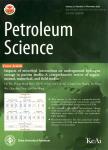Experimental study of reservoir damage of water-based fracturing fluids prepared by different polymers
作者机构:Engineering Technology Research InstituteXinjiang Oilfield CompanyKaramay834000XinjiangChina Luliang Oilfield Operation AreaXinjiang Oilfield CompanyKaramay834000XinjiangChina China University of Petroleum-Beijing at KaramayKaramay834000XinjiangChina
出 版 物:《Petroleum Science》 (石油科学(英文版))
年 卷 期:2024年第21卷第5期
页 面:3298-3306页
核心收录:
学科分类:0820[工学-石油与天然气工程] 08[工学] 082002[工学-油气田开发工程]
主 题:Fracturing fluid Guar gum HPAM Gel-breaking fluid Formation damage
摘 要:Fracturing operations can effectively improve the production of low-permeable reservoirs. The performance of fracturing fluids directly affects the fracturing efficiency and back flow capacity. As polymerbased fracturing fluids(such as guar gum(GG), polyacrylamide(HPAM), etc.) are high-viscosity fluids formed by viscosifiers and crosslinking agents, the degree of gel breakage after the fracturing operation directly influences the damage degree to the reservoir matrix and the mobility of oil angd gas produced from the reservoir into the wellbore. This study compared the viscosity, molecular weight, and particle size of the fracturing fluid after gel breakage prepared by GG and HPAM as viscosifiers, as well as evaluate their damage to the core. Results show that the viscosities of the gel-breaking fluid increased with the concentration of the viscosifier for both the HPAM-based and GG-based fracturing fluids. For the breaking fluid with the same viscosity, the molecular weight in the HPAM-based gel-breaking fluid was much larger than that in the GG-based system. Moreover, for the gel-breaking fluid with the same viscosity, the molecular particle size of the residual polymers in the HPAM-based system was smaller than that in the GG-based system. The damage to the core with the permeability of 1 × 10^(-3)μm^(2) caused by both the HPAM-based and GG-based gel-breaking fluids decreased with the increase in the solution viscosity. For the gel-breaking fluid systems with the same viscosity(i.e., 2-4 mPa s), the damage of HPAM-based fracturing fluid to low-permeability cores was greater than the GG-based fracturing fluid(45.6%-80.2%) since it had a smaller molecular particle size, ranging from 66.2% to 77.0%. This paper proposed that the damage caused by hydraulic fracturing in rock cores was related to the partilce size of residual polymers in gel-breaking solution, rather than its molecular weight. It was helpful for screening and optimizing viscosifiers used in hydraulic f




